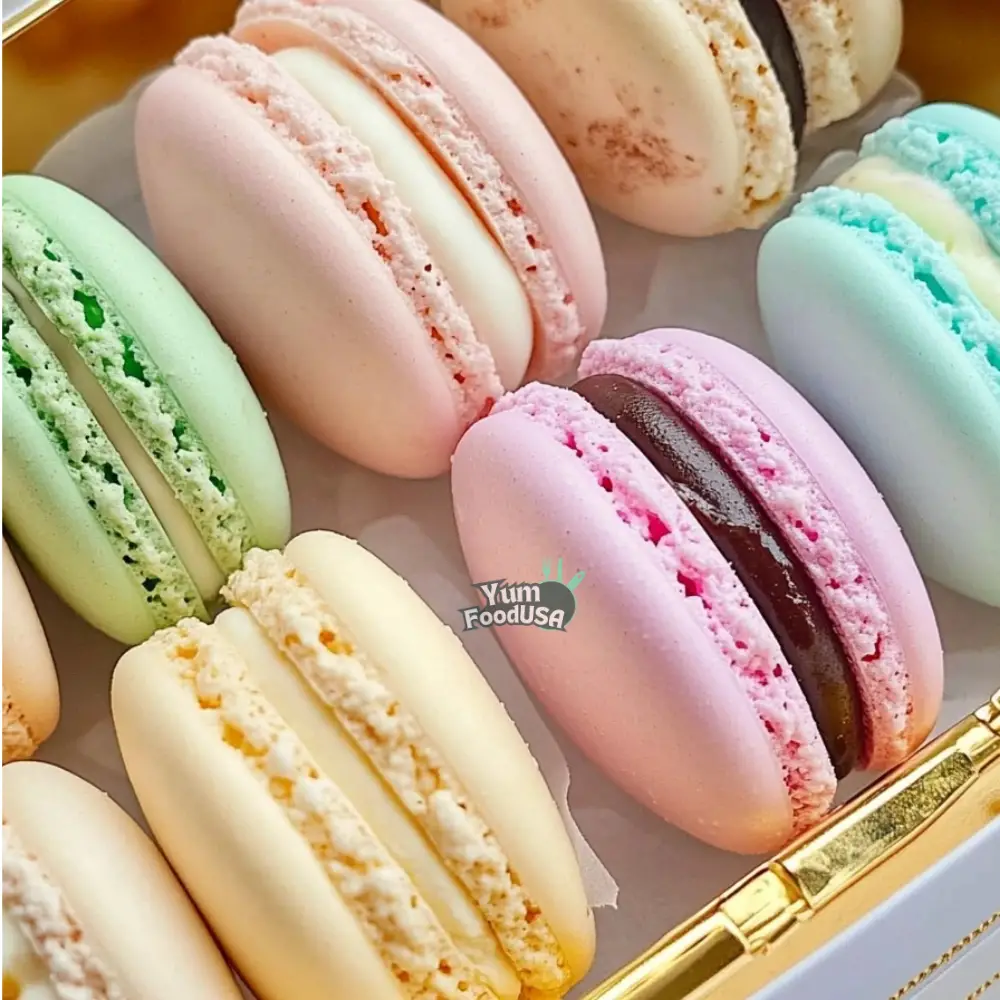Macarons are one of the most beloved and visually stunning desserts, known for their crisp outer shell, soft interior, and flavorful fillings. Yet, despite their beauty, they are notoriously tricky to perfect. Many home bakers struggle with cracked shells, hollow centers, or uneven textures. So, what makes macarons so difficult? Let’s break it down, explore their fascinating history, and share an easy recipe for beginners.
The History of Macarons: From Italy to Paris
The macaron has a long and fascinating history. While often associated with France, its origins trace back to Italy. The word macaron comes from the Italian maccarone, meaning a fine dough. The earliest version of macarons was brought to France by Catherine de Medici’s Italian pastry chefs in the 16th century when she married King Henry II.
However, the macarons we know today—two delicate almond meringue shells sandwiched with a rich filling—were perfected in Paris by Ladurée and Pierre Desfontaines in the 20th century. Since then, they have become a worldwide symbol of elegance, creativity, and culinary precision.
Why People Love Macarons
- Aesthetic Appeal – Macarons are beautiful, coming in soft pastels and vibrant hues, often decorated with edible gold, dried flowers, or artistic designs.
- Endless Flavor Combinations – From classic vanilla and chocolate to exotic flavors like lavender honey, matcha yuzu, or black sesame, macarons offer endless variety.
- The Perfect Bite – The combination of crisp, chewy, and creamy textures makes them irresistible.
- Luxury and Tradition – Macarons are often associated with famous patisseries like Ladurée Paris, making them a sought-after treat.
- Great for Special Occasions – Whether it’s Christmas, weddings, or afternoon tea, macarons add an elegant touch to any celebration.
Why Most People Fail at Making Macarons
Despite their simple ingredient list (egg whites, almond flour, powdered sugar, and granulated sugar), macarons are notoriously tricky to get right. Here are the most common reasons why:
1. Improper Macaronage (Mixing Technique)
Macaron batter must be folded just right—not too much, not too little. Overmixing leads to runny batter, while undermixing results in lumpy shells. The batter should flow like lava and form ribbons that disappear within 10 seconds.
2. Humidity Ruins Everything
Macarons are highly sensitive to moisture. If your kitchen is humid, the shells may not form a proper skin, leading to cracks or flat cookies. Avoid making macarons on rainy days or use a dehumidifier.
3. Skipping the Drying Step
After piping, macarons need to rest until they form a dry, touchable skin (usually 30-60 minutes). This helps create the signature smooth top and ruffled “feet” at the base. Skipping this step leads to cracked shells.
4. Wrong Oven Temperature
Macarons require precise heat. Too high, and they crack. Too low, and they don’t rise. Most recipes work best at 300°F (150°C), but always test your oven with an oven thermometer.
5. Using the Wrong Almond Flour
Superfine almond flour is crucial for smooth macaron shells. If your flour is too coarse, the texture will be grainy. Always sift your almond flour and powdered sugar together for a flawless finish.
Popular Variations of Macarons
- Classic Parisian Macarons – Traditional almond-based shells filled with ganache, buttercream, or jam.
- Christmas Macarons – Festive flavors like peppermint, gingerbread, or eggnog.
- Macaron Cake – Large macaron shells layered like a cake with creamy fillings.
- Pastel Macarons – Soft pinks, lavenders, and blues for a dreamy aesthetic.
- Savory Macarons – Unconventional flavors like goat cheese and fig or truffle and parmesan.
Easy Macaron Recipe for Beginners
If you’re intimidated by macarons, try this simple, fail-proof recipe!
Ingredients:
- 1 cup (100g) almond flour
- 1 ¾ cups (200g) powdered sugar
- 3 large egg whites (room temperature)
- ¼ cup (50g) granulated sugar
- ½ tsp vanilla extract
- Food coloring (optional)
Directions:
- Prepare Dry Ingredients: Sift almond flour and powdered sugar together to remove lumps.
- Make the Meringue: Whisk egg whites in a clean, grease-free bowl until foamy. Gradually add granulated sugar, beating until stiff, glossy peaks form.
- Fold the Batter (Macaronage): Gently fold the dry ingredients into the meringue using a spatula. Continue folding until the batter flows like thick lava.
- Pipe the Shells: Transfer batter to a piping bag and pipe small circles onto a lined baking sheet. Tap the tray to remove air bubbles.
- Rest the Shells: Let them sit at room temperature for 30-60 minutes until they form a skin.
- Bake: Preheat oven to 300°F (150°C). Bake for 12-15 minutes until they have risen and formed “feet.” Let cool before filling.
- Fill and Assemble: Pair shells and fill with ganache, buttercream, or jam. Enjoy!
Macaron Filling Ideas
- Chocolate Ganache – Rich and creamy, perfect for classic macarons.
- Raspberry Buttercream – A fruity, slightly tart filling for balance.
- Pistachio Cream – Nutty and luxurious.
- Lemon Curd – Bright and tangy for a refreshing twist.
- Salted Caramel – Sweet and salty perfection.
Decorating Macarons Like a Pro
Want your macarons to look extra cute and Instagram-worthy? Try these ideas:
- Gold Splatter: Use edible gold paint for a luxurious look.
- Macaron Art: Draw designs with edible food markers.
- Pastel Ombre: Blend soft pinks, blues, or purples for a dreamy effect.
- Edible Flowers: Garnish with dried rose petals or lavender.
- Christmas-Themed: Decorate with festive colors and tiny sugar decorations.
Final Thoughts
Macarons are an art, requiring patience, precision, and practice. While they may seem difficult at first, mastering the right techniques will make all the difference. Whether you’re making classic Ladurée-style macarons or experimenting with bold flavors, the effort is always worth it. With the right tips, even beginners can create these delicate, picture-perfect treats!
Why Macarons Fail: Common Mistakes and How to Perfect Them
If you’re intimidated by macarons, try this simple, fail-proof recipe for perfectly crisp shells and chewy centers!
- Prep Time: 35 minutes
- Setting Time: 30–60 minutes
- Cook Time: 15 minutes
- Total Time: 1 hour 30 minutes
- Yield: 20 macarons (10 filled) 1x
- Category: Dessert
- Method: Baking
- Cuisine: French
- Diet: Gluten Free
Ingredients
- 1 cup (100g) almond flour
- 1 3/4 cups (200g) powdered sugar
- 3 large egg whites (room temperature)
- 1/4 cup (50g) granulated sugar
- 1/2 tsp vanilla extract
- Food coloring (optional)
Instructions
- Prepare Dry Ingredients: Sift almond flour and powdered sugar together into a bowl. Discard any large pieces to ensure a smooth batter.
- Make the Meringue: In a clean bowl, beat egg whites until frothy. Gradually add granulated sugar while whipping until stiff, glossy peaks form. Mix in vanilla extract and food coloring (if using).
- Macaronage Process: Gently fold the dry ingredients into the meringue using a spatula. Mix until the batter flows like lava and forms ribbons that disappear in 10 seconds.
- Pipe & Rest: Transfer batter into a piping bag fitted with a round tip. Pipe small circles onto a parchment-lined baking sheet. Tap the tray to remove air bubbles. Let macarons rest for 30–60 minutes until a skin forms.
- Bake: Preheat oven to 300°F (150°C). Bake macarons for 12–15 minutes until they have set and formed “feet.” Let them cool completely before removing from the tray.
- Fill & Enjoy: Pair similar-sized shells and fill with buttercream, ganache, or jam. Let macarons mature in the fridge for 24 hours for the best texture.
Notes
- Use aged egg whites (separated and left in the fridge for 24 hours) for best results.
- Avoid humid environments, as moisture affects macaron shells.
- Test if macarons are ready to bake by gently touching them—if they don’t stick, they’re good to go!


